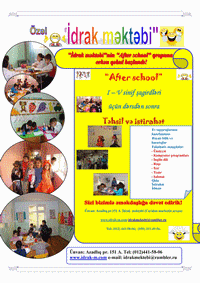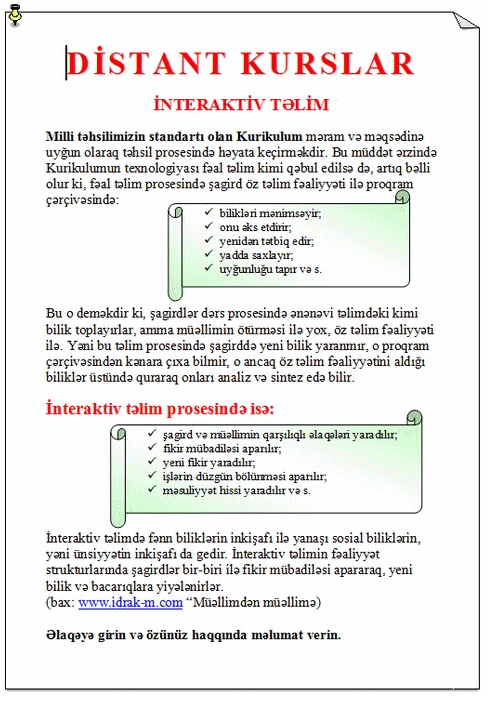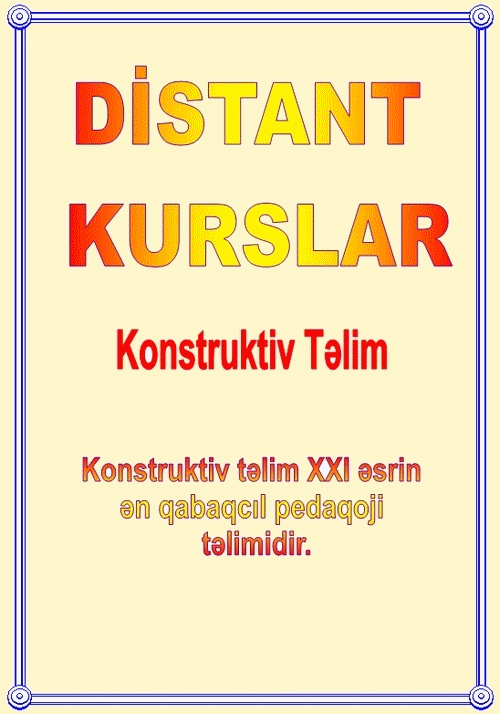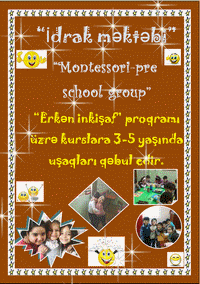En
Constructive Teaching Technology and Perspectives of Nanopsychopedagogy.
The cognitive theories of learning admit the importance of the intellect in the process of comprehension of training material. In the XX century Piaget, Vygotsky and Brouner submitted a great contribution to the theory of cognition. In the world pedagogical and psychological community the cognitive theories of Piaget, Vygotsky, Bruner and other teaching theories which totally admit the importance of intellect are unified under the title of constructivism (Funderstanding-5). From our point of view the constructivism is a psycho-pedagogy and it is a formation of the educational process on the base of pedagogy and psychology. Constructivism is an avant-garde of the pedagogical technology (Luis Bench-7). The presented Technology of Constructive Teaching is a result of research and practical activity of the Azerbaijan –“Intellect school” during the last 20 years.
Pedagogical Technology. Bunyatova’s Constructive Teaching.
Constructive teaching is a creative, active – operational way of teaching, which gives an opportunity to each student to form his / her own knowledge based on his / her experience. The philosophy of suggested Constructive Teaching (CT) is the synthesis of eastern and western teaching philosophies; this is the step from particular knowledge to the integrity knowledge or vice versa, from the integrity to the particular. Constructive Teaching is aimed at changing the teacher’s and student’s activities during the training process, at the end of which some changes occur not only in the training process but also all its corresponding components. One of the main components of traditional teaching is the educational aim: its “Knowledge”, “Ability”, “Skill” slightly transforms into “Comprehension”, “Ability”, “Knowledge” and “Generation”.
The presented CT principles have a number of coincidences with the constructivist pedagogues’ principles and at the same time there are some differences between them.
What are the coincidences?
- Search of the topic sense. If the student comprehends the sense of the topic
- The Integral Scheme of Knowledge Structure. – Based on Piaget’s conception of intellect the knowledge formed within the scheme of integrity coincides with the opinion that the knowledge should be presented within the context, in the form of spiral. (Jerome Brouner)
- Intellectual models. Like all other representatives of the constructivism we ascertain that each stage of development corresponds to its task and its operational activities (Piaget – 10)
- Structure of the lesson. A lesson is designed in three parts;
- Activity structure.
- Knowledge structure.
- Structure of thought processes.
In particular, there are similarities but at the same time some differences
The noticeable differences are the following:
- It is suggested to plan the structure of subject knowledge in the form of a logical structure of knowledge. What is the logical structure of knowledge? – Using Piaget’s logical apparatus it was revealed that knowledge can be logically connected, disconnected, associated with and presented in a new meaning, identified and notified.
- Logical Operations of thinking – that is the structure of thinking activities, in other words structure of the intellect activities. In a counterbalance with simple tasks and exercises it is suggested to hold further logical thinking operations within the logical structures of the knowledge i.e. to carry out operational activities over the knowledge.
A logical operation over the logical structure of the knowledge (LSK) destroys the vertical knowledge structure (traditional approach) and lines them up in a horizontal structure. (Bunyatova F. D -8)
In this horizontal structure the following find their base:
- The Integrity logic ( Piaget-9)
- Invariant of the knowledge (Piaget)
- Zade’s linguistic logic (R.Aliyev-10)
- Zade’s elements
- Zade’s precise and non-precise sets
Bringing the ideas of two experts of XX century Piaget and Zade to the school process raises a great deal of questions in psycho-pedagogy and in its new tendency (Alizadeh A.-15). A new tendency in psycho-pedagogy can be created, it will be a nanopsychopedagogy. Nanopsychpedogogy can do the following innovation in education:
- The designed content of the subject knowledge based on Piaget’s intellect logic and Zade’s linguistic logic. This formal logical design will be produced by designing technology of the nanostructural knowledge (F.D.Bunyatova-9)
- Logical modeling of knowledge content is seen as a logical base of the subject knowledge building of the digital school. Subject knowledge structures will be built isomorphically by intellect structure. This logical structure will be a genetic development program of each student as well. Difference in students’ development will be temporarily i.e. one student will pass it at a speed of X, the other at a speed of X¹.
- Logical modeling of knowledge destroys vertical knowledge structure and builds them horizontally (F.D.Bunyatova-9)With such structural approach, during studying the integrity of knowledge each student having built integrity scheme of their knowledge will be developed based on their natural abilities and talents.
- The Logical design of the subject knowledge content will decrease the training time to 20-30 percent and here it can be found the affirmation of the appeal by Seymur Perpert in the 80-s of the XX century. “There should be created such educational technologies which could decrease the teaching period up to 2-3 years”.
- The comparative machine translation by Bunyatova. Having been created on the basis of the above mentioned formal-logical model of a material language the same model of another language can be created. Then the comparative machine translation of a language into another will be based on the SG technology.
Bunyatova’s constructive teaching (CT) principles:
The first principle. Topic meaning retrieval.
In CT the lesson begins with the topic meaning retrieval, in other words with determining the reality of the studied topic.
The second Principle – The integral scheme of knowledge structure.
The knowledge structure in CT is presented for learning in the scheme of integrity. Each studied knowledge structure contains the previous structures and set the entrance to the next structure of knowledge.
The third principle.
Bunyatova’s logical knowledge structure. Using Piaget’s logical integrity methods within the content of subject knowledge the following logical ties, relations and dependence among the knowledge structures have been defined:
Compatible structures.
Consenting with common relations two knowledge structures are linked up and form a new knowledge structure.
Reversible structures.
The knowledge structures united with common relations are reversible and are able to be transformed.
Associative structures
Reasoning always keeps its ability to decline and to find other solutions to the problem. At the end the result gained from difference is the same.
Annihilated structures
The knowledge structure can be annulled, disappeared, abolished if it is multiplied by zero.
Identical structures
Two identical structures can be united and form a single complex structure.
The logical knowledge structures (LKS) revealed in knowledge are basic parts of constructive teaching.
The fourth principle. The logical operations of reasoning.
1.The Classification Operation
With the help of this operation students gain intellectual skills for dividing the ensemble into sub-ensembles according to certain indications.
2.The Serialization operation.
Conducting a logical serialization operation students gain skills to group knowledge structures according to their united indications or to one single indication.
3.The Substitution Operation.
By this operation one structure is substituted by another one (example: in mathematics the substitution of figures with letters (6+7) = (a + b); substitution of mathematical characters (5×5=5² and etc.).
4.Enrichment Operation.
Conducting this operation on knowledge structures, students having their own knowledge enrich themselves with new knowledge structures and turn them into new knowledge. Enrichment operation as substitution operation generates the future knowledge from the gained knowledge.
5.Multiplicative Operations
This operation is applied on several knowledge structures at the same time which have common relations and links.
The fifth principle. Intellectual Models of Students
In constructive teaching the knowledge of each student passes through three stages: intuitive, concrete and formal.
The quantity of knowledge passed through these stages is the product of student’s intellect activity, his / her wealth, and his / her diversity.
The sixth principle. Lesson structure
The lesson in constructive teaching is planned structurally. The teacher plans logical knowledge structure, structures of thinking activity and structures of student’s educational activities.
The goal of Constructive Teaching
1. Educational:
Comprehension. Knowledge. Skills. Generation. This target is achieved via self- improving, self- understanding, self-realizing.
2. Pedagogical:
Balancing student’s own behavior is the reflection of inner understanding expressed by means of speech and outer actions.
Seven elements of constructive teaching lesson planning.
1. Searching.
Searching is a tool for teacher to understand and determine students’ knowledge level on a given topic, the perspectives of its increase, its application and the comprehension of the topic essence and its meaning by the students.
2. Structures.
In C. T. as it was mentioned above, the lesson is formed structurally.
- it is the logical structure of the knowledge (Antipina -14)
- it is the structure of educational activity (Kagan-4)
3. Mental logical operation
Thinking operations are orders, directions expressed by the verb.
4. Connection.
This element serves to connect one knowledge structure with another one. Through this connection not only structural links within subject knowledge are clearly seen but connection among subjects as well.
5. Questions.
While designing (Constructivist Learning Design-3) a lesson the teacher should determine with which question he /she will begin the lesson and which question he / she will end it. Questions put by teacher helps him / her to determine what the students know about the topic, how they imagine it, how they explain their opinion arguing about it or raise the problem in case of incomprehension.
6. Addition and Connection.
This element of the lesson serves as a connection between previous and future knowledge. The teacher’s addition into this knowledge connection often changes them qualitatively.
7. Presentation or Reflection.
The teacher in CT prepares work list for the team consisting of 4 persons or for an individual beforehand. In this list he puts the questions, directions, gives tasks depending on the set aim. Tasks and directions should cover the work done during the lesson. They should begin with easier tasks and smoothly pass into more complicated ones. This process contains not only understanding, but also deep comprehension.
Lesson in constructive learning consists of 2 parts:
The first stage of the lesson covers the work on the topic.
The direction of this stage of the lesson:
— Searching, determining the meaning of the topic, determining the place of topic in knowledge system, work on topic, connection of the studied topic with other knowledge, the result.
The second stage of the lesson.
This stage of the lesson usually takes 20-25 minutes and is aimed at the reflection on knowledge gained by students.
The role of Teacher and students in Constructive Teaching. The evaluation of students’ activities.
In Constructive Teaching the teacher is a manager of the lesson and manages the lesson. Managing the lesson he / she as a mediator directs the students’ thought to the set up line, creating conditions for gaining new knowledge, connecting the questions discussed by students among themselves. Creating logical prerequisites and directives the teacher sets directions for students to transforming their knowledge to the higher quality level. He encourages the brightest ideas, creative approaches, original and alternative answers. It stimulates every student to present their own opinions more precisely, more brightly and in its turn that gives a powerful incentive to self-development and creativity. The control and assessment are carried out in the form of tests, taxonomy, daily checks, sharing by teacher and by students themselves. While working in this regime (routine) the students develop such social and intellectual skills, as realizing the reality, the ability to listen to others and accept their opinions, the ability to solve the problem, skills of analyzing and synthesizing, calculating, reconstruction and creation of a new one, enrichment of their knowledge and etc. All of these have a great influence on equation and crystallization of the behavior in the social and intellectual sphere.
Key words:
- Logical structure of knowledge;
- Logical thought operations;
- Nanostructure of knowledge;
- Nanopysichopedagogy;
- Horizontal building of knowledge structure;
- Formal-logical modeling of the subject knowledge- knowledge nanostructure;
- The comparative machine translation
RESUME
The technology of constructive learning is presented as a nanopsychopedagogical approach to learning. This is a creative-active learning. It puts student’s intellect in the forefront, creates circumstances in which every student builds up their own knowlodge based upon his/her existing experience and sets up an individual transition bridge to the future knowledge. The constructive teaching principles, its difference from constructivist approaches to teaching , structures and elements of the lesson are discribed in the article. This technology is based on Piaget’s logic integrity ( or completeness ) and on Zade‘s linguistic logic. Combining two logics in one single technology creates a new tendency in psychopedagogics – nanopsychopedagogies and profiles of changes are being outlined to which the tendency can be led in education. Principles of constructive education, elements of a lesson are described and the roles of teachers and students in this process of knowledge are given as well in the article.
Fatma khanum Bunyatova
Head principle of “Intellect school”
Used literature:
- Bruner. J. (1973), Going Beyond the information Given, New York; Norton).
- Cordon Dryden and Dr. Jeannette Vos the learning web. 1999
- Constructivist Learning Design by George W. Gagnon, Jr. and Michelle Colay.
- Cooperative learning Dr. Spenser Kagan resources for teachers, Inc.
- Funderstanding “About learning Constructivism”.
- Smith, M. R. (2002) Jerome S. Bruner and the process of education, the encyclopedia of informal education http (www.infed.org/thinkers/bruner.htm)
- Luis Bench, Constructivism html.
- Логический способ обучения. Альтернативное образование. 1991. Баку. Бунятова Ф. Д.
- Ф. Д. Бунятова. Применение нечётной логики в образовательных технологиях. Copyright Agency of the Azerbaijan Republic № 328. 01.07.02. Baku.
- Жан Пиаже. Москва 2001 г.
- Р. А. Алиев, Soft computering. Баку. «АзДНА», 1999 г.
- Педагогическая технология. Конструктивное обучение. 2007-Eidos-internet-magazine.
- Konstruktiv təlim. Mahiyyəti, prinsip, vəzifələr və dərslərdən numunələr. F. C. Bunyatova, Bakı, 2008
- Antipina J. İ. Pedaqoji texnologiya. Bunyatovanın konstruktiv təlimin müəllif metodikası. www.ellib.az
- Ə. Əlizadə. İdrak prosesləri və hisslər. Bakı 2006
- «Жан Пиаже в школе» Elmi axtarışlar, 2002








Very nice site! is it yours too
Have you checked your site with different web browsers? I’m using IE 7 and the layout is a bit off.
I think other website owners should take this internet site as an model, very clean and great user pleasant style and design . reseller hosting | best reseller hosting |
How could I have missed this blog! Its extraordinary. Your style is flawless, like you know exactly what to do to do make men and women flock to your page! I also like the perspective you brought to this subject. Its like you might have an insight that many people havent seen prior to. So fantastic to read a weblog like this.
Enjoy ones site as its directly to the point but not technical. I’m keen on gadgets as well as anything tech connected thats the reason why i posted right here. are you carrying out some sort of up-date soon because I am engaged in your niche. I am going to return before long and even sign up to your blog. cheers.